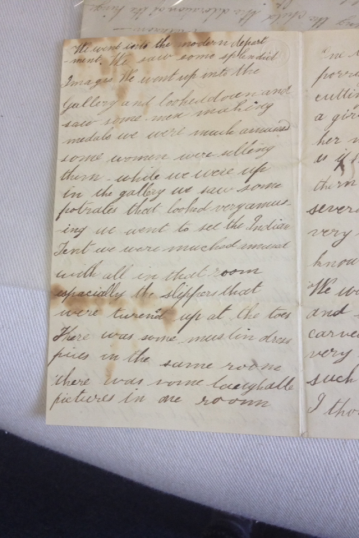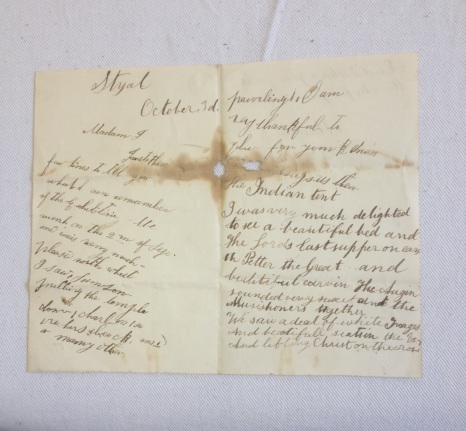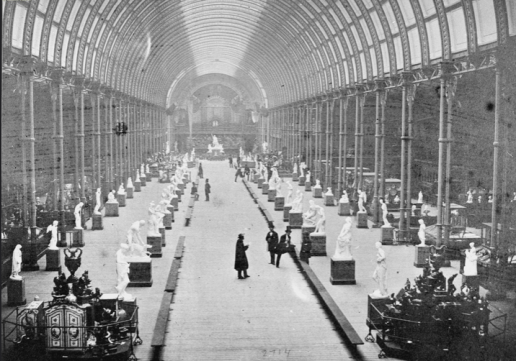Hi,
This week Helen our Collections and Archive Intern discovered some letters written by workers at Quarry Bank. I could not wait to find out more, so over to Helen.
Working in the archives, it can sometimes be easy to overlook the day to day experiences of the workers at the mill amongst the many records we have of the Greg family. Thankfully, there are also innumerable snippets of social history tucked away that act as timely reminders of the lives of those working here. As I learnt last week, the sources of these snippets are often completely unexpected.
Whilst sifting through the Worker’s Records, you can’t help but hear each individual’s personality coming through and to me their voices could not have been clearer than in several thank you letters written to Margaret Greg in 1857 after a trip to the Art Treasures Exhibition.
These letters are such a welcome change from the usual Victorian formality that runs through much of the Greg family correspondences. Instead, the workers enthuse about their visit, writing just as they would talk.
They don’t hesitate in telling Mrs Greg about their amusement at some of the pieces on display. One worker, Margaret Walker, writes, ‘…we saw some potrates[sic.] that looked very amusing we went to see the Indian Tent we were muched[sic.] amused with all in that room especially the slippers that were turend[sic.] up at the toes’.

Mary Henshall candidly tells Margaret Greg that ‘there was some very laughable pictures in one room’. This is exactly why I love these little pieces- they’re entirely different from the norm. They’re so conversational that reading them is really like hearing the writers of these letters describing their visit to their own families.
Amusingly, each letter almost uniformly begins or ends with an apology. As Mary Moore writes, ‘I am very sorry that I did not write to you before now you made me a presend[sic.] which I was very much oblige to you for’.

At first, reading these, some of which are identical word for word, it was funny to imagine a bemused Margaret Greg receiving these and noticing the pattern. But as you go on, you realise that the task of writing a letter was no mean feat for the average worker.
Reading the letters, it looks like one or two family members, possibly possessing a greater grasp of grammar, had been asked to produce template letters, which have then been carefully copied down by others.
Nevertheless, Quarry Bank Mill workers enjoyed a fuller education than most working class communities, where the hope of even being able to write was entirely distant.

The really charming thing about these letters is that despite being templates, the workers would often insert their own descriptions or tangents amongst the copied text, and it’s these bursts of personality coming through that make the letters so interesting.
Hannah Mary Venables’ voice is unmistakable, where she writes that she ‘saw so many of the visiters[sic.] noticing a group of Ladies [and] gentlemen whilst one of the gentlemen was talking very fast pointing out the paintings to them. We was informed that they wer[sic.] the Royal family of Wertemberg [Wurttemberg]’.
There are also moving glimpses into quite how much the workers valued the trip, with Mary Henshall writing, ‘The musicians began to play at two o’clock and we sat down and listened and I am sure I never heard any music so beautiful as that before’.
The Gregs were known for their unusually generous treatment of their workers, and these letters are the perfect examples of that generosity.
The Art Treasures Exhibition itself was a huge event, displaying fine art from all over the world, and is still considered to be one of the largest art exhibitions the UK has ever seen.

What’s more, it was not held in London, but instead on the outskirts of industrial Manchester at Old Trafford. This building, designed to resemble London’s extravagant Crystal Palace, once dominated the area near what is now the site of Manchester United’s stadium.

The exhibition’s approach to its visitors was also somewhat progressive- we know that the admission ticket was reduced from half a crown, to sixpence when entering after 2pm in an attempt to entice a broader range of society to visit rather than targeting only the middle and upper classes.

Although this scheme was abandoned due to a lack of revenue, it signalled a change in prejudiced attitudes towards the working classes, where they were being increasingly seen as part of society rather than beneath it. There’s no doubt that the workers’ enjoyment of the exhibition proves the worth of their visit.
These letters certainly give you a fascinating and fresh perspective of the personalities that have helped to form the story of the mill and the opportunity they shared to experience Victorian grandeur.
The work done in the archive as part of the Quarry Bank Project is helping us to discover more about Quarry Bank and it’s history. To find out more about the project, please visit our website.
Helen

Hi,,I dont know why you allude to the fact that Hannah Mary Venables was “Mancunian”. She most certainly wasnt ! I think its more a case of a spelling mistake,,and nothing at all to do with any accent. Regards Mike great great great grandson of Hannah,,,and a proud Mancunian.
Dear Mr Lee, We have taken out the word ‘Mancunian’ and in hindsight we appreciate that the choice of word was not appropriate. We are really sorry that this may have caused offence, it was certainly not intended to do so.’
Kate
Hello!
Thank you very much for the blog post, it was incredibly enlightening. I am currently working on my MA thesis which looks at the A-T Exhibition, and I am wondering if there is anyway I could access the archive to view the letters- they would be a fantastic resource
Thanks in advance
Lewis
Hello Lewis,
I’ve passed your enquiry on and one of our archive team will be getting back to you. All the best with your MA, it sounds fascinating.
Emma